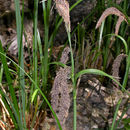Comments
provided by eFloras
Carex obnupta largely replaces C. barbarae north of California and is distinguished from it by the acute scales and the glossy dark brown perigynia that lack veins and have an entire, membranous beak. It is an abundant, almost weedy, plant.
Carex obnupta occasionally hybridizes with C. nudata.
- license
- cc-by-nc-sa-3.0
- copyright
- Missouri Botanical Garden, 4344 Shaw Boulevard, St. Louis, MO, 63110 USA
Description
provided by eFloras
Plants not cespitose. Culms obtusely or acutely angled, 20–120 cm, glabrous. Leaves: basal sheaths red-brown; sheaths of proximal leaves bladeless, scabrous, fronts with red-brown spots, prominently ladder-fibrillose, apex U-shaped, red-brown; blades hypostomic, 3–7 mm wide, coriaceous, papillose abaxially. Inflorescences: proximal bract longer than inflorescence, 3–6 mm wide. Spikes arching, at least the proximal pendent; staminate 2–3(–5); pistillate 2–5; proximal pistillate spike usually sessile, 2.5–15 cm × 5–10 mm, base attenuate. Pistillate scales red-brown, longer and wider than perigynia, apex acute, awnless. Perigynia divergent, brown, veinless, somewhat inflated, loosely enclosing achenes, ellipsoid or obovoid, 2.2–3.8 × 1.4–2.2 mm, leathery, glossy, apex rounded, glabrous; beak colorless or with red-brown spots, 0.1–0.3 mm, orifice hyaline. Achenes often constricted on 1 or both margins, glossy; style base often bent. 2n = 70, 72, 74.
- license
- cc-by-nc-sa-3.0
- copyright
- Missouri Botanical Garden, 4344 Shaw Boulevard, St. Louis, MO, 63110 USA
Brief Summary
provided by EOL authors
carex obnupta is a sedge that occurs in the far west of North America ranging form British Columbia to California. Chief characteristic habitats include wet meadows, pond shores and ditches ranging from sea level to 900 meters in elevation.
The species does not manifest a tufted growth form, but has a colonial occurrence, with an extensive underground rhizome network. The glabrous culms are angled and can attain a height of 1.2 meters. The leathery, glossy capsules are brown, veinless, with ellipsoid or obovoid shape.
Comprehensive Description
provided by North American Flora
Carex obnupta L. H. Bailey, Proc. Calif. Acad. II. 3: 104. 1891
"Carex cryptocarpa C. Meyer" Dewey, Am. Jour. Sci,. 29: 245. pi. W, f. 69. 1836.
" Carex sitchensis Prescott " Boott, in Hook. Fl. Bor. Am. 2 : 220. pi. 221. 1839.
" Carex aquatilis Wahl." W. Boott, in S. Wats. Bot. Calif. 2: 241. 1880.
Carex magnifica Dewey; Holm, Am. Jour. Sci. IV. 17: 316. 1904. (Type from Columbia River.)
.'Carex Schottii Dewey" Kukenth. in Engler, Pflanzenreich 4 20 : 365, in large part. 1909.
Forming beds, sending forth long, horizontal, stout, scaly stolons, the culms 3-15 dm. high, stout, stiff, sharply triangular, more or less roughened above, exceeding or exceeded by the leaves, strongly aphyllopodic and purplish at base, arising from the center of the evergreen leaves of the previous year, the lower sheaths of the flowering year breaking and prominently filamentose; sterile shoots strongly aphyllopodic and purple-tinged at base and with the basal sheaths prominently filamentose; leaves of the flowering year with well-developed blades usually 2-4 to a fertile culm (the bladeless basal sheaths conspicuous), the blades ascending or spreading, firm, coriaceous, 1-2 dm. long, 2.5-5 mm. wide, channeled above and keeled towards base, the margins revolute above, short or long-tapering, very rough on margins; sterile-culm and basal leaf -blades similar, but much longer (2-5 dm. long) ; sheaths more or less hispidulous and purplish-tinged, the ligule longer than wide; upper 1-3 spikes staminate, linear, 1.5-6 cm. long, 3-6 mm. wide, often curving, the terminal peduncled, the lateral sessile, the scales obovate, obtuse or mucronate, dark-reddish-brown to purplish-black, with lighter midrib and hyaline margins, the bracts enlarged, scale-like; pistillate spikes 2-4, erect, or from little to strongly spreading, or even strongly drooping, approximate or more or less separate, the lower slightly (or even very long) peduncled, the upper usually nearly sessile (rarely strongly peduncled), usually linear-cylindric, varying to oblong or linear, 3-14 cm. long, 4-10 mm. wide, usually staminate at apex, closely flowered (or sometimes loosely at base), with numerous ascending perigynia in many rows; lowest bract leaf-like, usually much exceeding culm, with darkcolored, often united auricles at base; upper bracts smaller but conspicuous; scales narrowly ovate, acute or acuminate, purplish-black with conspicuous, lighter, 3-nerved center and very narrow hyaline margins, wider or rarely slightly narrower than, and longer than and concealing perigynia; perigynia oval-ovate, biconvex, thickish, 2.5-3.5 mm. long, 1.5-2 mm. wide, coriaceous, yellowish-green when young, in age brown, 2-ribbed (the marginal), otherwise nerveless, shining, smooth, puncticulate, sometimes sparingly ciliate-serrulate, rounded and broadly substipitate at base, abruptly apiculate, the beak 0.3 mm. long, entire or nearly so; achenes lenticular, broadly or narrowly obovoid, nearly sessile, loosely enveloped, nearly filling perigynium, 2.25 mm. long, 1.4 mm. wide, deeply constricted in middle, minutely apiculate, jointed with the short straight style ; stigmas 2, slender, long.
Type locality: San Mateo County, California (Kellogg).
Distribution: Swampy meadows, Monterey Bay, California, northward to British Columbia; reported from southern Alaska. (Specimens examined from California, Oregon, Washington, Vancouver, Queen Charlotte Islands.)
- bibliographic citation
- Kenneth Kent Mackenzie. 1935. (POALES); CYPERACEAE; CARICEAE. North American flora. vol 18(7). New York Botanical Garden, New York, NY
Carex obnupta: Brief Summary
provided by wikipedia EN
Carex obnupta is a species of sedge known by the common name slough sedge. It is native to western North America from British Columbia to California where it grows abundantly in wet, often saline habitat such as wetlands. The plant produces upright, angled stems approaching 1.2 meters in maximum height, growing in beds or colonies from rhizome networks. The inflorescence is a cluster of flower spikes accompanied by a long leaflike bract. The pistillate spikes and sometimes the staminate spikes dangle on peduncles. The fruit is coated by a hard, tough, shiny perigynium which is generally dark in color.
- license
- cc-by-sa-3.0
- copyright
- Wikipedia authors and editors

